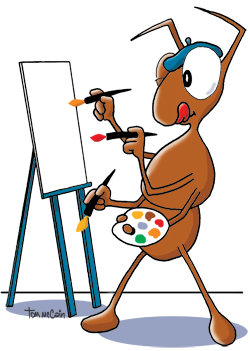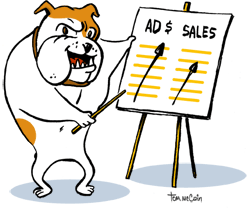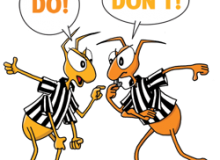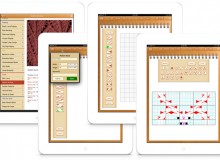 When Julia and I first began discussing this topic, we were determined to take an illustration vs. photography approach. But the more research I did, the less I wanted to talk about photography. It’s not a competition, really, but rather a matter of making a choice based on which form will best accomplish your marketing objectives.
When Julia and I first began discussing this topic, we were determined to take an illustration vs. photography approach. But the more research I did, the less I wanted to talk about photography. It’s not a competition, really, but rather a matter of making a choice based on which form will best accomplish your marketing objectives.
The Illustration Edge
According to the AIGA, the professional association for design, here’s what illustration can do for you: “Illustration can provide a unique sensibility to certain projects. Illustration brings spontaneity, freshness and a unique point of view to the design of content. It helps to communicate both simple and complex messages while enhancing a design through the unique vision and skill of the selected illustrator.”
“A Rationale for the Use of Illustration” published by Creativebusiness.com, offers further insight by noting that the new way of communicating in an age of tech-driven sameness is often the least technical and most unusual. Illustration cuts through today’s visual clutter to get ideas and products noticed. Illustration can:
- Provide the best solution to a problem. There often is no better way to capture and manipulate emotion, atmosphere, flavor and mood to validate an idea or maximize a product’s allure.
- Offer more flexibility. Reality has distinct limitations, but illustration can give personality and form to intangible ideas and concepts for which there are no practical photographic solutions. Think about:
- Presenting products not yet built
- Bringing back people and events long past
- Revealing hidden sections
- Communicating products that are in the works
- Adding, moving or eliminating surroundings
- Emphasizing details
- Reduce costs. Not only are there a growing number of stock illustration sites, but also keep in mind that virtually 100 percent of the costs of a commissioned illustration go directly into the creativity. There aren’t always travel costs, elaborate sets and other costs often incurred with a custom photo shoot.
If you’re considering stock—or just want to get inspired by the great illustrative styles that are out there—check out these sites:
http://www.hireanillustrator.com
http://www.behance.com
http://www.istockphoto.com
http://www.veer.com
http://www.gettyimages.com
When working directly with illustrators, we recommend creating a standard form that outlines your licensing requirements. For example, having a contract that says, “We pay $X for Y license for Z time or Q medium,” makes it really easy to accept because the illustrator knows how much, for what, for how long and where.
Illustration Meets Technology
Keep in mind that illustrators haven’t been lost in a time warp. In fact, many illustrators use Adobe Illustrator, Photoshop and other programs to create artwork that may include photography and other graphic elements. Ben Heine, a Brussels-based artist, combines photography and illustration to generate interesting images and new spaces that are comic, fun and a surreal. A new visual concept invented by Heine in 2010, the “Pencil vs. Camera” series encourages an expanded view of an otherwise normal subject. This technique has many possibilities for use in advertising, packaging and graphic communications.
Technology can also be used to animate illustrations in order to tell a story or convey an idea. Animated GIFs are a way to add animation to email campaigns (with caveats for newer versions of Outlook*) and Flash banners can be used in many magazine websites.**
 [/kml_flashembed] |
This banner ad for Prinova is a perfect example of using illustration to creatively communicate how customers can use Prinova’s ingredients in their food manufacturing solutions. Photography also would not have worked as well to introduce the new company tagline. If you’re reading this from a smart phone, the backup JPG is displayed. |
Remember that Original Artwork Belongs to the Illustrator
AIGA points out that an artist’s copyright is owned by the artist and is protected by the 1976 Copyright Act from the moment it is created. This protection covers the work for the artist’s lifetime plus 70 years. If agreed to in writing, the copyright may be assigned elsewhere, usually for an additional fee.
But original artwork is provided only temporarily to licensees for reproduction. Even the purchase of “exclusive rights” represents rights to reproduce the artwork only. The original illustration remains the property of the illustrator unless it is purchased explicitly and separately from the rights.
Original artwork also cannot be changed without the creator’s approval. Changes to an illustrator’s work must be made by the illustrator, unless you secure permission from the illustrator first. Many people are simply not aware of this law and unintentionally violate it. Please take the time to learn the rules of the road.
Call an Illustrator Today
There you have it—lots of reasons to incorporate more illustration into your communications. So get moving. Or do I have to draw you a picture?
By Larry Bauer
*Outlook 2007/2010/2013 and Windows Mobile 7 will display the first frame of an animated GIF so keep that in mind when building animations for email use. Most other email apps will indeed take advantage of the full animation. **While Flash is often an accepted format for website advertising, always provide a backup JPG in the event that users are viewing the website without Flash, such as via iPhones or iPads. Maybe it’s time to give yourself and your team a little pep talk. Get your facts straight. Know what you’re talking about. Create a results-oriented plan that will improve sales today and better position your company for tomorrow. You can do it. What’s more, you need to do it.
Maybe it’s time to give yourself and your team a little pep talk. Get your facts straight. Know what you’re talking about. Create a results-oriented plan that will improve sales today and better position your company for tomorrow. You can do it. What’s more, you need to do it.







